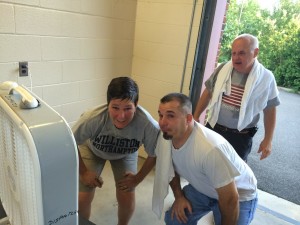
It was a typical summer morning for Security Manager Anne O’Connor. She began the day by clambering across the Reed Campus Center roof, looking for a good place to put a new emergency siren system. By that afternoon, she was checking in on a delivery of two new bicycles before heading over to the Easthampton Police Department for a face full of pepper spray as part of a safety training course.
Williston’s security manager, who joined the school last summer, admits that she’s been busy over the past couple of months.
“It’s been a busy, progressive year,” she said. “And I don’t see any slow down as far as our moving forward with security on campus.”
Since her hire last August, Ms. O’Connor has been quietly implementing a series of wide-ranging changes to the school’s security department. Those upgrades have included multiple new systems, equipment upgrades, changes to campus policies, and a series of training sessions that she hopes will not only create closer ties between the Easthampton emergency services and the school, but also strengthen the bonds between the security department as a whole.
But Ms. O’Connor began by simply walking through campus and strolling in and out of buildings.
“I wanted to sit back, watch, evaluate and see how people worked,” she said. “One of the very first things I did was that I went around every building.”
As a result of what she observed, Ms. O’Connor made a series of immediate changes: She secured emergency doors so they couldn’t be accessed from the outside, had Williston security personnel start wearing easily identifiable uniforms with their names sewn on the breast, and moved the department’s base of operations from the Physical Plant building to the Reed Campus Center, a high traffic area.
“These guys need to be up where everything is and that’s Reed,” she said of her staff. “They need to be in the heart of things.”
The changes have continued with a host of new software rollouts this summer. The security department now has Report Exec, a new software program to help staff track reports and any incidents on campus, and Rave Alerts, which can broadcast emergency alerts through text, email, and social media. In August, ATI Systems, a Boston-based company, will install two high-powered speakers—one at Galbraith and one on the roof of the Reed Campus Center—which can broadcast emergency notices across campus.
“The speakers can be voice activated,” Ms. O’Connor said. “So in the case of inclement weather, we can tell people there’s a storm coming.”
After testing the new systems over the summer, the security department will run live drills in the fall once students return to campus.
Head of School Robert W. Hill has applauded the changes and said that Ms. O’Connor “brought a wide ranging skill set and vast experience to our campus security.”
“Having worked on a college campus, she has direct knowledge of the larger issues that schools face and she has scaled those to Williston’s needs,” Mr. Hill said in an email. “With improved technology and renewed emergency planning procedures, Williston has done a tremendous job to ensure the community’s safety and preparedness.”
Ms. O’Connor, who was on the Sunderland police force for eight years and the Southampton force for another four, has also made strides in integrating the school’s security office more closely with local emergency and law enforcement.
After realizing that, to place an emergency call to the Easthampton Police Department, security staff had to use their cell phones, she also made sure the every Williston security officer had a new radio, through which they could reach the police dispatcher by pushing a single button.
“Coming in as ex-law enforcement, you see things very differently than people who are here,” she said. “That it is alright to leave every door open—that’s gone from every school.”
In July, Ms. O’Connor brought her staff to the Easthampton Police Department for a basic training course in OC, also known as pepper spray. As the Williston staff jotted notes, their instructor, Officer Robert Pouska, reviewed the procedures for using the spray—including how to deescalate a conflict so it would not have to be used.
“OC is a very low level use of force,” Officer Pouska said, clicking through a PowerPoint. “It can distract or stop a subject long enough for you to gain control.”

During a break in the session, security officer Kevin Donahue said the training was helping the staff keep their skills sharp and develop plans for all sorts of situations.
“It’s a different world out there now,” Mr. Donahue said. “In order to be an effective force, you have to keep up with the technology and new techniques—not only read it, but get engaged with it.”
Ms. O’Connor applauded her team following the training course, which included a short written test and also involved getting sprayed in the face with the OC spray—a painful process that she said united the staff as a team. A group picture after the ordeal showed the security officers, their faces swollen and red from the pepper, leaning together and grinning.
“Yesterday was a good base. They loved it. They thrived on it,” she said after the training. “I just put them through the most painful thing ever and they loved it.”
Ms. O’Connor is already looking ahead: to training courses in defensive tactics and to eventually hiring more part-time staff. She said she’s also been collaborating with the security teams at other independent schools to exchange ideas.
“For me, I want to be that department that everybody goes, ‘Wow. I want to be like them,’” she said. “We’re getting there—slow and steady.”

